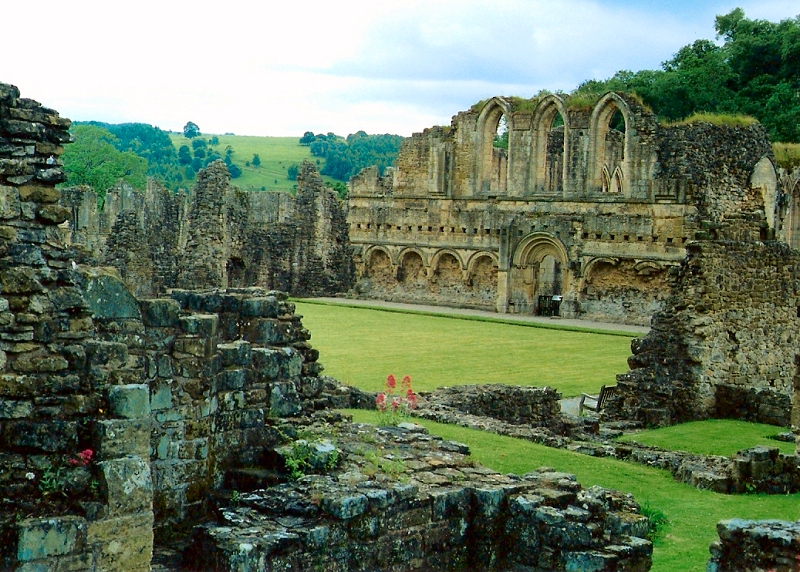
Lunch is at the Abbey Inn across from Byland Abbey, which we explored only the day before. I enjoy a ham and tomato sandwich and a half pint of ale. Having a drink in the afternoon is something I haven't done since those younger and wilder days that Dana and I were discussing earlier in the morning, but the bar has Blacksheep Ale on tap.
We had considered taking a tour of the Blacksheep Brewery in Masham on our journey from York to Catlowdy the next day, but learned that there was a tour of 200 people scheduled. How can I now pass up the only opportunity I might have to sample a local brew? I can't.
The pub is nicely decorated; the focal point being a large fireplace and, to me, a shelf that runs around the tops of the walls, lined with old books. After a few sips of Blacksheep, which is cold, smooth and very tasty, I'm tempted to stand on my chair to read the titles, but I control myself. Soon we are back in the car again and traversing the twisting roads through the Yorkshire countryside.
Rievaulx Abbey sits in a turn of a narrow valley along the River Rye. Like Byland, it appears seemingly out of nowhere from around a curve in the road. This makes for a very dramatic first impression. Built atop several man-made terraces, the abbey commands a broad view of lush green meadows framed by the tree-covered walls of the valley.
Founded in 1132, Rievaulx was the first Cistercian abbey in the north of England. Under the rule of its third abbot, St Aelred, the community grew to 150 choir monks and 500 lay-brothers. By the time the abbey was suppressed in 1538 there were only twenty-two monks remaining.
The visitors' center is very educational and fun, with a block slide-puzzle picturing the floor tiles, which are still visible in the monks' dormitory, and a display showing the techniques the monks used to process leather. There are also corbels, statues and other carvings that have fallen from the ruins over time.
Incredibly, we are practically alone again in this pastoral setting. I take shot after shot of arches and columns that comprise the ruins of the Nave, trying to imagine how it would look if it were roofed. Slender, fragile flying buttresses support the high vault of the Presbytery. Down the sloping ground, room after room of dormitory are laid out, each with a narrow border of decorated tiles still showing. These rooms are so small, and I understand why they are called cells. A portion of the cloister arcade has been rebuilt from fallen masonry showing surprisingly delicate columns.
I stand in the remains of the kitchen (which I consider apropos, and am not missing in the slightest) and study the monks' refectory. After the church, the refectory, or dining hall, was the largest and most elaborately decorated building at the abbey, and much of this one is still standing. Flanking the doorway are arches where stone water-troughs for washing (the laver) would have been. Looking behind me at a small stucco cottage with red-tiled roof I imagine what it would be like to live amid such ruins. I wonder if the woman who lives there, who had earlier made a brief appearance in her garden, takes all of this wonder for granted.
If this were my kitchen, and I were looking out of the little window over my sink onto these sights, I think, I'm sure I would stand and gape open-mouthed until the dishwater grew cold. It is definitely a room with a view.
I draw a deep breath of fresh country air and stand silent for a moment, taking one last moment to absorb the serene atmosphere of Rievaulx. As we meander through a meadow filled with clover and busy bumblebees, we make one last discovery. Very little is left of what used to be a huge building, but for several large deep troughs that resemble ancient bathtubs. I realize that this is the tannery and picture the monks stirring animal hides, soaking in sheep urine, in these vats. I'm suddenly appreciating, even more, the fresh country air.
A snack of a Magnum bar (which puts Dove ice cream bars to shame, and which I can't begin to finish) and we're off through the Yorkshire countryside once more, heading toward Ripon Cathedral.

Rievaulx Abbey was a Cistercian abbey in Rievaulx, situated near Helmsley in the North York Moors National Park, North Yorkshire, England. It was one of the great abbeys in England until it was seized under Henry VIII of England in 1538 during the dissolution of the monasteries.
The abbey lies in a wooded dale by the River Rye, sheltered by hills. The monks diverted part of the river several yards to the west in order to have enough flat land to build on. They altered the river's course twice more during the 12th century.
The old course is visible in the abbey's grounds. This is an illustration of the technical ingenuity of the monks, who over time built up a profitable business mining lead and iron, rearing sheep and selling wool to buyers from all over Europe.
Rievaulx Abbey became one of the greatest and wealthiest in England, with 140 monks and many more lay brothers.
Read more about Rievaulx Abbey at Wikipedia.